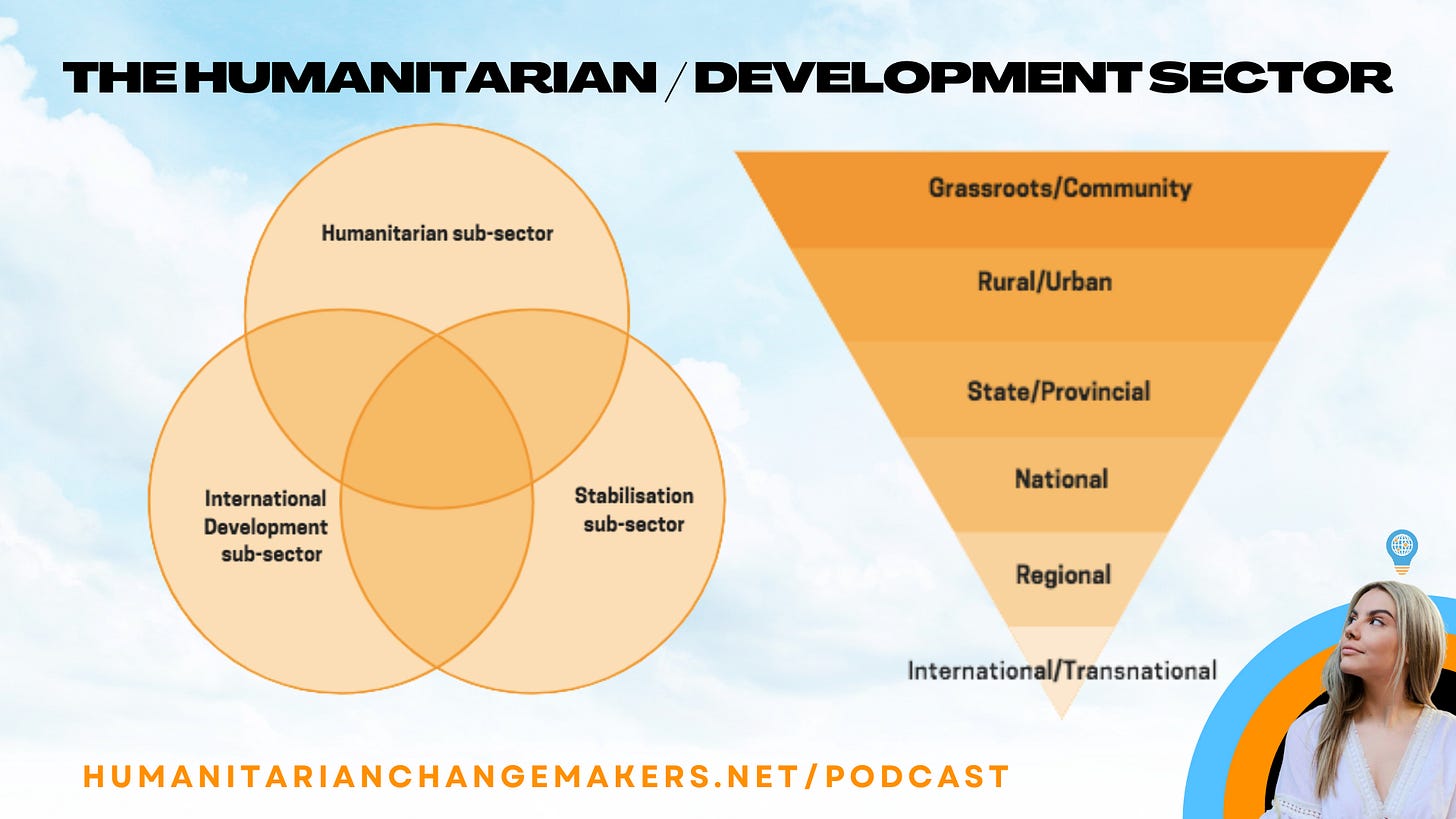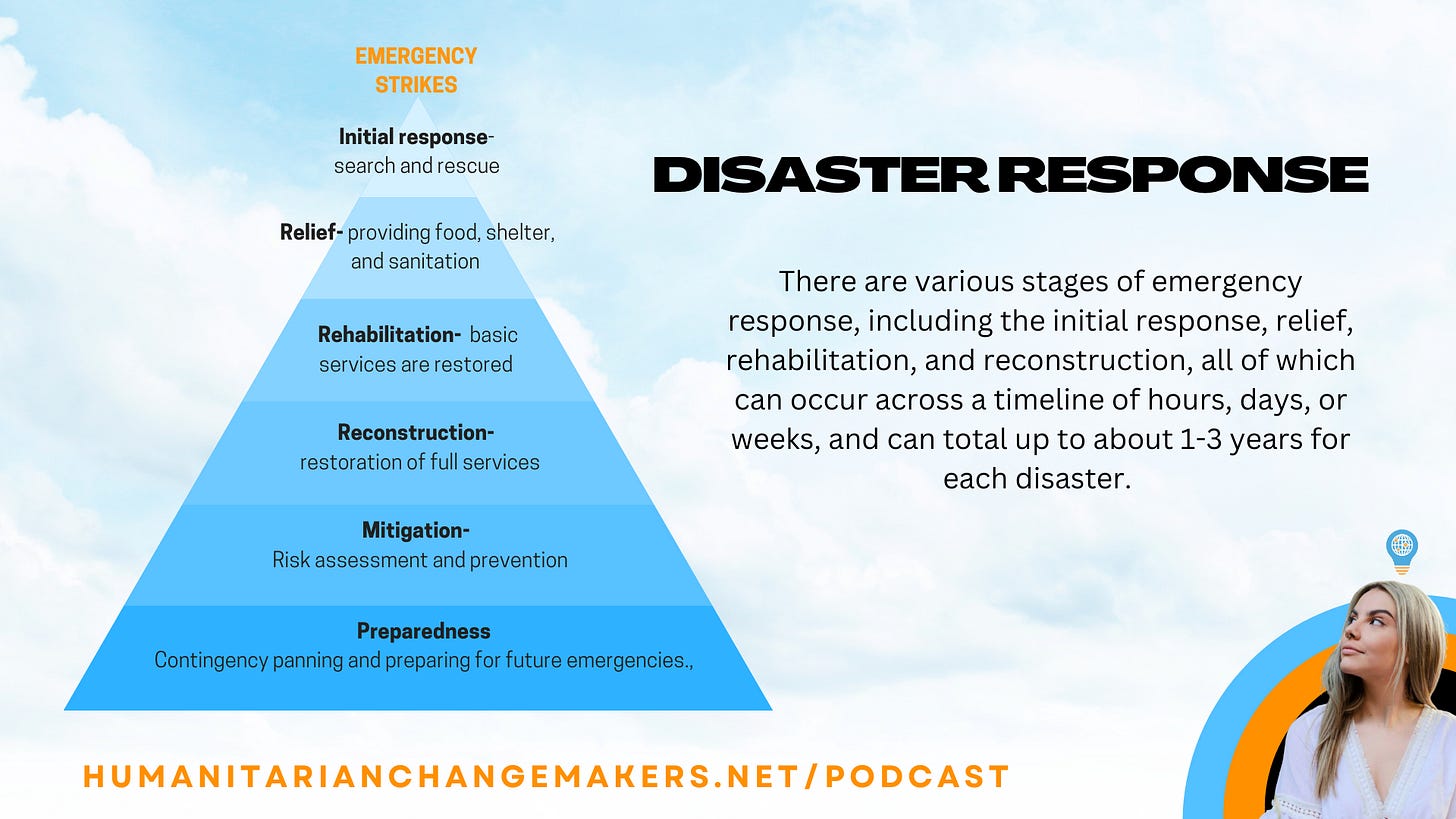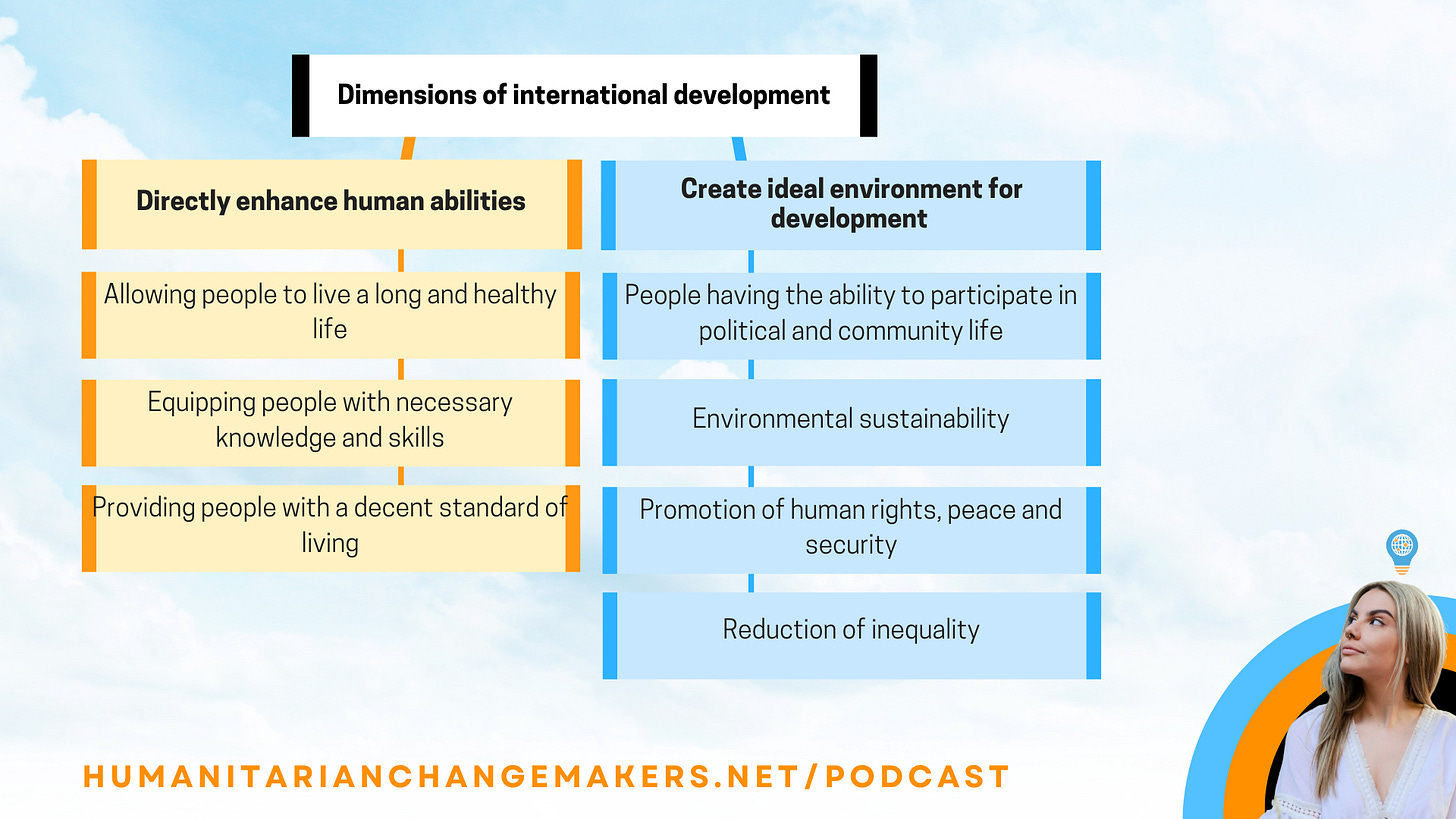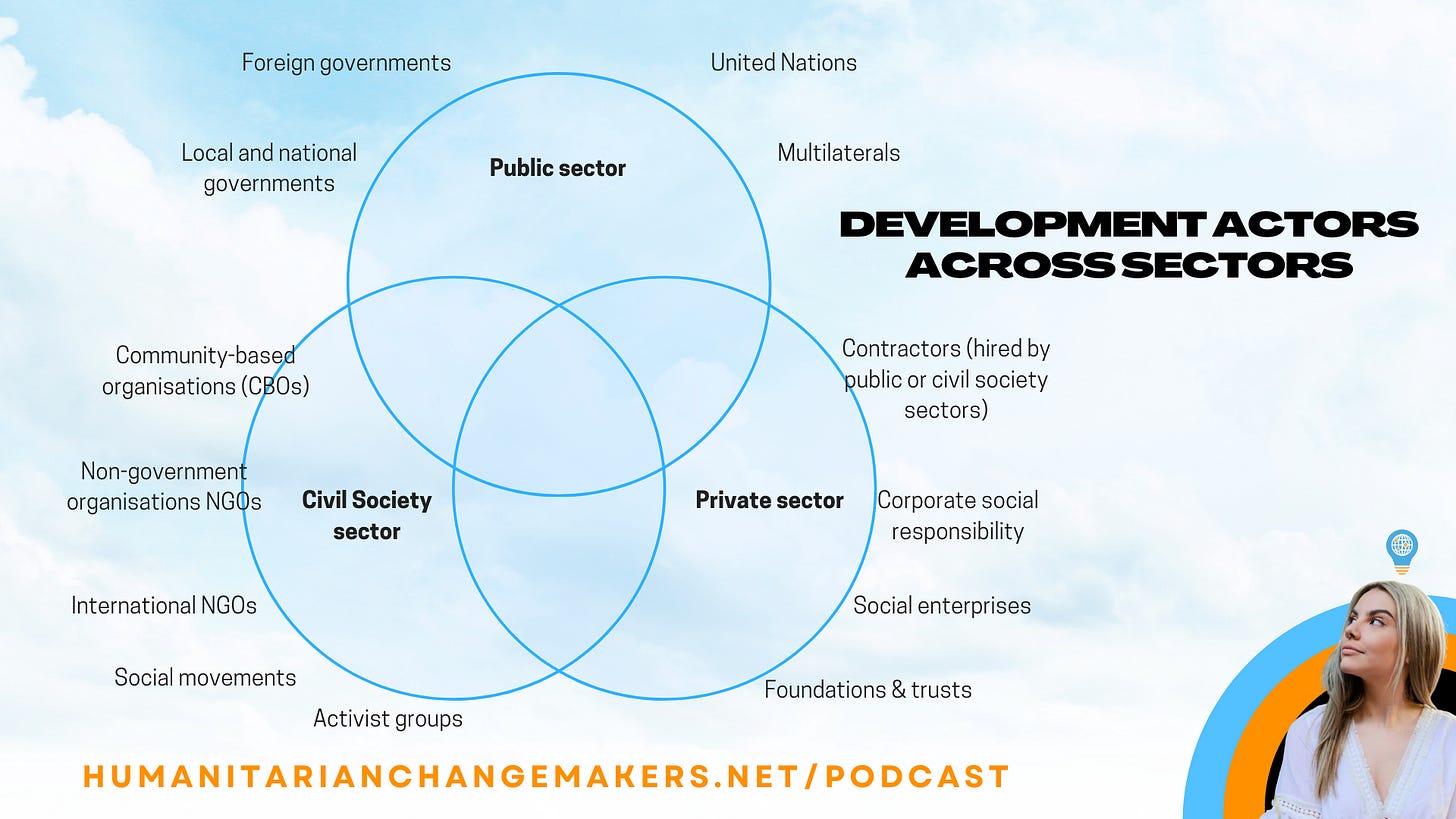How the Humanitarian and Development Sectors Shape Our Communities
028. From Relief to Resilience: Understanding the Humanitarian Aid and Development Sectors
Did you know that the international development and humanitarian sector is a $1 trillion industry? This makes it the equivalent of the 8th largest economy in the world, employing over 18 million people. While this may seem like a vast amount of money, research suggests that achieving the United Nations’ Sustainable Development Goals (SDGs) will require an additional $5 trillion. As a result, financial resources remain relatively scarce in the humanitarian sector, despite its scale and impact.
You may already be considering a career in the humanitarian sector, or you might be wondering what exactly the humanitarian sector entails. Simply put, the role of a professional humanitarian is to promote human welfare and social reform, with no prejudice. Understanding how the humanitarian sector functions, the actors involved, and the tasks assigned to different stakeholders is essential for those seeking to engage in humanitarian projects or pursue a long-term career in the field.
The humanitarian and development sector is composed of three interrelated sub-sectors: the humanitarian sub-sector, the development sub-sector, and the stabilisation sub-sector. The humanitarian sub-sector is primarily concerned with responding to crises and emergencies, providing immediate life-saving aid such as food, shelter, and medical assistance following disasters or conflicts. The development sub-sector, in contrast, focuses on long-term social and economic progress, aiming to enhance human capabilities and create sustainable systems that enable communities to thrive. The stabilisation sub-sector sits at the intersection of these two, working in conflict-affected or fragile states to restore security, governance, and political stability through a combination of civilian, military, and diplomatic efforts. While each sub-sector has distinct goals and approaches, they often overlap, particularly in post-crisis recovery, where stabilisation efforts support both humanitarian relief and long-term development initiatives.
Stages of Humanitarian Response
The humanitarian sector primarily responds to disasters and emergencies. Humanitarian response can be broken down into six key stages, each requiring different skill sets and approaches. These stages include:
Initial Response (Search and Rescue) – Immediately following a disaster, the priority is to locate and rescue survivors. This phase involves emergency responders, medical teams, and logistics specialists coordinating life-saving efforts in affected areas. Time is critical, as the window for rescuing those trapped or injured narrows rapidly.
Relief (Food, Shelter, and Sanitation) – Once survivors are secured, the focus shifts to meeting basic needs such as food, water, shelter, and sanitation. Humanitarian organisations distribute emergency supplies, establish temporary shelters, and provide urgent medical care to prevent disease outbreaks.
Rehabilitation (Basic Services Restored) – In this phase, attention turns to restoring essential services, including water supply, healthcare, and education. This transitional stage ensures that affected communities can begin regaining a sense of stability, even before full-scale reconstruction begins.
Reconstruction (Restoration of Full Services) – Long-term rebuilding efforts commence, focusing on reconstructing homes, infrastructure, and public services. Engineers, urban planners, and policymakers work to rebuild communities in a way that enhances resilience to future disasters.
Mitigation (Risk Assessment and Prevention) – Mitigation efforts involve identifying risks and implementing measures to reduce vulnerabilities. This can include enforcing building codes, developing early warning systems, and investing in sustainable infrastructure to withstand future crises.
Preparedness (Contingency Planning and Preparing for Future Emergencies) – The final stage involves proactive planning to ensure a swift response to future disasters. This includes training emergency responders, stockpiling essential supplies, and educating communities on disaster preparedness.
The preparedness phase serves as the crucial link between humanitarian aid and international development. Once communities are better prepared for future emergencies, the focus transitions toward long-term development efforts.
The Role of the Development Sector
While the humanitarian sector addresses immediate crises, the international development sector works to create sustainable solutions that enhance long-term resilience. The development sector operates with two core objectives:
Directly Enhancing Human Abilities – This involves equipping individuals and communities with the necessary knowledge, skills, and resources to improve their quality of life. Programs may include education initiatives, vocational training, and healthcare improvements.
Creating an Enabling Environment for Development – Beyond individual capacity-building, development practitioners work to establish the systemic conditions necessary for sustained progress. This includes strengthening governance, improving infrastructure, and fostering economic opportunities.
Development efforts are interdependent on humanitarian work, particularly in post-disaster settings where sustainable recovery requires both short-term assistance and long-term investment. Without a stable environment, development initiatives struggle to take root, while without development-focused policies, disaster-affected communities remain vulnerable to recurring crises.
The Stabilisation Sector: Bridging Humanitarian and Development Work
The stabilisation sector exists at the intersection of humanitarian response and international development. It involves efforts to reduce violence, re-establish security, and promote political stability in post-conflict and disaster-affected areas. Unlike the humanitarian and development sectors, which operate on principles of neutrality and independence, stabilisation efforts often involve coordinated civilian and military actions to foster structural stability.
Actors in the Humanitarian & Development Sector
Various actors contribute to the humanitarian sector, each playing distinct yet interconnected roles. These include:
Civil Society Organisations – Local community groups and non-governmental organisations (NGOs) that work directly with affected populations.
International NGOs – Large-scale humanitarian organisations such as the International Red Cross and Médecins Sans Frontières, which provide immediate relief and support long-term recovery.
Government Agencies – National and international government bodies that coordinate disaster response and fund recovery efforts.
Private Sector – Businesses that provide financial support, technological innovations, and logistical expertise for humanitarian operations.
United Nations Agencies – Organisations such as the World Food Programme (WFP) and the United Nations High Commissioner for Refugees (UNHCR), which play a crucial role in global emergency response and policy coordination.
The humanitarian sector offers diverse career opportunities, from frontline emergency response to policy development and program management. Common entry points into humanitarian work include:
Volunteering and Internships – Many professionals begin by working with NGOs, gaining hands-on experience in disaster-affected areas.
Technical Expertise – Engineers, medical professionals, logisticians, and data analysts are in high demand across various humanitarian roles.
Program Management – Coordinating large-scale humanitarian projects requires skills in project management, monitoring, and evaluation.
Policy and Advocacy – Shaping humanitarian policies and securing funding for aid programs are critical components of the sector.
As professionals progress in their careers, they may specialise in specific aspects of humanitarian aid, development, or stabilisation efforts, moving into senior leadership roles that influence global policies and strategies.
The humanitarian and development sectors are deeply interconnected, with humanitarian aid providing the foundation for long-term development. By understanding the distinct yet overlapping roles of these sectors, professionals can better navigate the complex landscape of humanitarian work and contribute meaningfully to global efforts in disaster response and sustainable development. Whether working in emergency relief, risk mitigation, or community development, each role plays a vital part in shaping a more resilient and equitable world.





